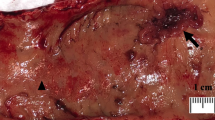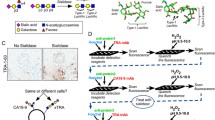Abstract
PURPOSE: Sialyl Tn (STn) antigen is a cancer-associated carbohydrate antigen expressed in cancers of the digestive tract. We compared the proportion of specimens of flat-type colorectal cancers expressing STn with that of polypoid cancers, by examining the immunohistochemical reactivity of STn in various morphologic types of early and advanced colorectal cancers. METHODS; A total of 111 biopsies from the colorectal area were examined for STn expression, including 11 adenomas, 58 early cancers, and 42 advanced cancers. Each section was stained immunohistochemically for STn antigen. In each section, we examined STn expression in the cancer area, adjacent mucosa, and normal epithelium. RESULTS: STn expression was detected in 90.9 percent of adenomas, 36.2 percent of early cancers (T1), 64.3 percent of advanced cancers (>T1), and 52 percent of mucosa adjacent to cancer. The morphology of cancer tissue did not influence the number of specimens exhibiting STn antigen expression in mucosa adjacent to cancer cells. STn antigen was rarely expressed in flat or depressed-type early cancers (T1; 7.1 percent), and the expression was higher in moderately than in well-differentiated adenocarcinomas. In advanced cancers (>T1), a similar proportion of protruding and small ulcerative cancers expressed STn. CONCLUSION: Our results suggest that the low expression of STn antigen in flat-type cancers may be the result of different mechanisms of cellular transformation during carcinogenesis from the usual adenoma-carcinoma sequence in colorectal neoplasms.
Similar content being viewed by others
References
Ajioka Y. Histogenesis and development process of colorectal carcinoma (in Japanese). In: Yoshida Y, ed. Shokakibyo Semina 46 Tokyo: Herusu Syuppan, 1992:49–62.
Kasumi A, Kratzer GL. Fast-growing cancer of the colon and rectum. Am Surg 1992;58:383–6.
Nagasako K, Sato S, Yashiro K, Suzuki S, Fujimori T. Natural history of superficial colorectal early cancers—from superficial to ulcerated lesions (in Japanese). Shokaki Naishikyo 1993;5:289–96.
Crawford BE, Stromeyer FW. Small non polypoid carcinomas of the large intestine. Cancer 1983;9:1760–3.
Rubio C, Shetye J. Flat adenoma-adenocarcinoma sequence in the colon of rats. Dis Colon Rectum 1994;37:1300–6.
Fujimori T, Satonaka K, Hirayama D,et al. Expression of ras oncogene product (p21) and point mutation of Ki-ras codon 12 in superficial early colorectal cancer (in Japanese). I to Cho 1992;27:111–7.
Yamagata S, Muto T, Uchida Y,et al. Lower incidence of K-ras codon 12 mutation in flat colorectal adenomas than in polypoid adenomas. Jpn J Cancer Res 1994;85:147–51.
Nanashima A, Tagawa A, Nakagoe T,et al. Relationship between morphological diversity and AgNORs or cathepsin B expression in colorectal cancers. Jpn J Gastroenterol 1996;31:646–53.
Nanashima A, Tagawa Y, Morinaga M,et al. Quantitative analysis of numerical chromosome aberrations in various morphological types of colorectal carcinomas. Jpn J Gastroenterol 1996;31:793–800.
Sasaki K, Sato T, Kurose A, Uesugi N, Ikeda E. Monosomy of chromosome 18 detected by fluorescencein situ hybridization in colorectal tumors. Cancer 1995;76:1132–8.
Filipe MI, Branfoot BM. Abnormal patterns of mucus secretion in apparently normal mucosa of large intestine with carcinoma. Cancer 1974;34:282–90.
Dawson PA, Filipe MI. An ultrastructural and histochemical study of the mucus membrane adjacent to and remote from carcinoma of the colon. Cancer 1976;37:2388–98.
Matsushita Y, Yamamoto N, Shirahama H,et al. Expression of sulfomucins in normal mucosae, colorectal adenocarcinomas, and metastases. Jpn J Cancer Res 1995;86:1060–7.
Yanagida T, Oya M, Ishikawa H. Growth patterns of colorectal carcinoma and mucin property of transitional mucosa (in Japanese). Nippon Shokakibyo Gakkai Zasshi 1996;93:1–9.
Itzkowitz SH, Yuan M, Montgomery CK,et al. Expression of Tn, sialosyl-Tn, and T antigens in human colon cancer. Cancer Res 1989;49:197–204.
Itzkowitz SH, Bloom EJ, Kokal WA, Modin G, Hakomori S, Kim YS. Sialosyl-Tn: a novel mucin antigen associated with prognosis in colorectal cancer patients. Cancer 1990;66:1960–6.
Ørntöft TF, Harving N, Langkilde NC.O-linked mucin-type glycoproteins in normal and malignant colon mucosa: lack of T-antigen expression and accumulation of Tn and sialosyl-Tn antigens in carcinomas. Int J Cancer 1990;45:666–72.
Lin TR. Evaluation of transitional mucosa of colon with special reference to sialylated antigen and nuclear DNA content. Acta Med Nagasaki 1992;37:229–33.
Itzkowitz SH. Blood group-related carbohydrate antigen expression in malignant and premalignant colonic neoplasms. J Cell Biochem 1992;16:97–101.
Jass JR, Filipe MI. Sulphomucins and precancerous lesions of the human stomach. Histopathology 1980;4:271–9.
Takahashi I, Maehara Y, Kusumoto T,et al. Predictive value of preoperative serum sialyl Tn antigen levels in prognosis of patients with gastric cancer. Cancer 1993;72:1836–40.
Miles DW, Linehan J, Smith P, Filipe I. Expression of sialyl-Tn in gastric cancer: correlation with known prognostic factors. Br J Cancer 1995;71:1074–6.
General Rules for Clinical and Pathological Studies on Cancer of the Colon, Rectum and Anus. Japanese Research Society for Cancer of the Colon and Rectum. 5th ed. Tokyo: Kanehara Syuppan, 1994:5–8.
Nagasako K, Satonaka K, Hirayama D, Fujimori T, Maeda S. A clinico-pathological study on the mucosal heights of superficial type (Type) early colon cancer (in Japanese). Nippon Shokakibyo Gakkai Zasshi 1991;88:763.
Ogata S, Ho I, Chen A,et al. Tumor-associated sialylated antigens are constitutively expressed in normal human colonic mucosa. Cancer Res 1995;55:1869–74.
Riddell RH, Levin B. Ultrastructure of the “transitional” mucosa adjacent to large bowel carcinoma. Cancer 1977;40:2509–22.
Robey-Cafferty SS, Ro JY, Ordonetz NG, Cleary KR. Transitional mucosa of colon: a morphological, histochemical, and immunohistochemical study. Arch Pathol Lab Med 1990;114:72–5.
Jass JR, Sobin LH, eds. Large intestine: the World Health Organization's histological typing of intestinal tumours. 2nd ed. London: Springer, 1989:29–40.
Pandey S, Gordon PH, Wang E. Expression of proliferation-specific genes in the mucosa adjacent to colon carcinoma. Dis Colon Rectum 1995;38:462–7.
Author information
Authors and Affiliations
About this article
Cite this article
Nanashima, A., Nakagoe, T., Sawai, T. et al. Different expressions of sialyl Tn antigen between polypoid and flat-type early colorectal cancers. Dis Colon Rectum 40 (Suppl 10), S37–S42 (1997). https://doi.org/10.1007/BF02062018
Issue Date:
DOI: https://doi.org/10.1007/BF02062018




